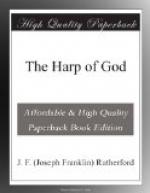[235]The Scriptures clearly show that Jesus was the antitypical bullock and was made an offering for sin on behalf of mankind; first on behalf of the church, subsequently on behalf of the whole world. “Christ died for our sins according to the Scriptures” (1 Corinthians 15:3); “who gave himself for our sins, that he might deliver us from this present evil world, according to the will of God and our Father” (Galatians 1:4); “for he hath made him to be sin [an offering for sin] for us, who [Jesus] knew no sin; that we might be made the righteousness of God in him".—2 Corinthians 5:21.
[236]The law that God gave to the Israelites merely foreshadowed what great things Jesus would do. Because of the imperfections of mankind—Moses and others—that law could not accomplish the deliverance of mankind from death. “For what the law could not do, in that it was weak through the flesh, God sending his own Son in the likeness of sinful flesh, and for sin, condemned sin in the flesh.”—Romans 8:3.
[237]In the type, the slaying of the bullock and the carrying of its blood into the Holy as a typical sin-offering foreshadowed the fact that the redemption of man’s sins could be accomplished only through the blood of the perfect sacrifice. And for this reason says the apostle Paul: “Without the shedding of blood is no remission. It was therefore necessary that the patterns of things in the heavens should be purified with these; but the heavenly things themselves with better sacrifices than these.” (Hebrews 9:22,23) The patterns here referred to are the Holy and Most Holy in the tabernacle picture, which foreshadowed or pictured the heavenly condition; and the entrance of the high priest into the Most Holy of the tabernacle with the blood foreshadowed Christ Jesus entering heaven. “For Christ is not entered into the holy places made with hands, which are the figures of the true; but into heaven itself, now to appear in the presence of God for us.”—Hebrews 9:24.
[238]When Jesus died upon the cross of Calvary he provided the ransom-price, because his was the death of a perfect human being, exactly corresponding with the perfect man Adam. Adam’s death, however, was the result of a forfeited right to live. Jesus’ death was a sacrifice. Adam was a sinner and died a sinner. Jesus was perfect, holy, and without sin; and while he died in the same manner, yet by his death he did not forfeit the right to live as a human being. By dying he reduced his perfect human life to an asset that might thereafter be used to release Adam and his offspring from death.
[239]We here give an illustration to aid in understanding this point. For convenience we will call a man John. John is languishing in prison because he cannot pay a fine of one hundred dollars. He has a brother named Charles who is willing to pay the fine for his brother John, but who has no money with which to pay. Charles is strong and vigorous, has time to work, is willing to work, and can earn




